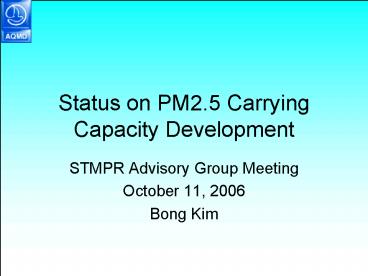Status on PM2.5 Carrying Capacity Development - PowerPoint PPT Presentation
1 / 20
Title:
Status on PM2.5 Carrying Capacity Development
Description:
EPA recommends modeling as many days as feasible where observed PM2.5 is greater ... each quarter (top 25% of PM2.5 days) if the sample size for each quarter is ... – PowerPoint PPT presentation
Number of Views:74
Avg rating:3.0/5.0
Title: Status on PM2.5 Carrying Capacity Development
1
Status on PM2.5 Carrying Capacity Development
- STMPR Advisory Group Meeting
- October 11, 2006
- Bong Kim
2
Overview
- Base and future year emissions v3 draft AQMP
emissions - Base year simulation results
- New PM standards
- New PM2.5 guidance document
- Future year simulation results
- Annual average PM2.5
- 24 Hour average PM2.5
3
South Coast Annual Average Emissions, tons/day
4
Error plots of PM2.5
5
New PM Standards
- On September 21, 2006, EPA issued new NAAQS for
PM - Annual PM2.5 standard retained at 15 ug/m3
- 24 hour PM2.5 standard strengthened to 35 ug/m3
- Annual PM10 standard revoked
- 24 hour PM10 standard retained at 150 ug/m3
6
New 24 Hour PM2.5 Standard
- EPA will make designations of attainment status
by November 2009 - Designations will become effective in April 2010
- PM2.5 SIP will be due in April, 2013
- States must meet the standards by April 2015,
with a possible extension to April 2020
7
New PM2.5 Guidance Document
- EPA released new PM2.5 guidance document on
September 21, 2006 - EPA recommends the attainment test for PM2.5 the
Speciated Modeled Attainment Test (SMAT)
8
SMAT for the Annual NAAQS
- Divide observed mass concentrations into 7
components plus passive mass - NH4
- NO3
- SO4
- OC
- EC
- Particle bound water
- Other primary inorganic PM
- Blank (0.5 ug/m3)
9
SMAT for the Annual NAAQS
- Step 1 Calculate annual design values for each
quarter for each site based on 3 year averages
from 2003-2005 FRM data - Step 2 Calculate average concentrations of 7
components for each quarter for each site from
Mates 3 data - Water from AIM model or a regression equation
- Step 3 Calculate fractional composition of
non-blank mass for each component for each
quarter for each site from Mates 3 data
10
SMAT for the Annual NAAQS
- Step 4 Apply fractional compositions from step
3 to annual design values from step 1 to
calculate base year concentrations for each
component for each quarter for each site - Step 5 Calculate rrf for each component for
each quarter for each site based on base and
future year simulations - Step 6 Apply rrf to base year concentrations
from step 4 for each quarter for each site and
calculate future year water concentrations
11
SMAT for the Annual NAAQS
- Step 7 The 4 quarters are then averaged to get
a final future year annual average PM2.5
concentrations for each site and compared to 15.0
ug/m3
12
Future Year Modeling Results
13
2005 Annual Average FRM PM2.5
ug/m3
Fed. Std.
14
PM2.5 - 2014 Base
ug/m3
Fed. Std.
15
PM2.5 - 2020 Base
ug/m3
Fed. Std.
16
PM2.5 - 2014 Control
ug/m3
Fed. Std.
17
PM2.5 - 2020 Control
ug/m3
Fed. Std.
18
PM2.5 Annual Average Conc.
ug/m3
Fed. Std.
19
PM2.5 Annual Average Conc.
ug/m3
Fed. Std.
20
SMAT for the 24 Hour NAAQS
- Similar to the test for the annual NAAQS
- EPA recommends modeling as many days as feasible
where observed PM2.5 is greater than 65 ug/m3 - EPA recommends the test focus on the high end of
the distribution in each quarter (top 25 of
PM2.5 days) if the sample size for each quarter
is smaller than about 5 days































